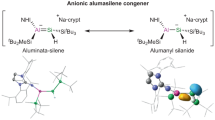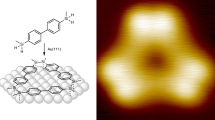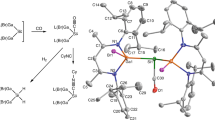Abstract
Silicon can form bonds to other tetracoordinated silicon atoms and these bonds form the framework of many organosilicon compounds and crystalline silicon. Silicon can also form a pentacoordinated anionic structure—a so-called ‘silicate’. No compounds containing a direct bond between two silicate moieties—‘disilicates’ where two silicate structures are combined in one species—have been reported because of the electronic repulsion between the anionic halves and difficulty preventing the release of anions. Here we report the synthesis of thermally stable and isolable disilicates by the reductive coupling reaction of a silane bearing two electron-withdrawing bidentate ligands. Two pentacoordinated silicons, positively charged despite the formal negative charge, constitute a single σ-bond and bind eight negatively charged atoms. They can be reversibly protonated, cleaving two Si–O bonds, to afford a tetracoordinated disilane. Their unique electronic properties could be promising for the construction of functional materials with silicon wire made up of silicate chains.
This is a preview of subscription content, access via your institution
Access options
Subscribe to this journal
Receive 12 print issues and online access
$259.00 per year
only $21.58 per issue
Buy this article
- Purchase on Springer Link
- Instant access to full article PDF
Prices may be subject to local taxes which are calculated during checkout




Similar content being viewed by others
References
Fischer, J., Baumgartner, J. & Marschner, C. Synthesis and structure of sila-adamantane. Science 310, 825 (2005).
Chuit, C., Corriu, R. J. P. & Reye, C. in Chemistry of Hypervalent Compounds (ed. Akiba, K.-y.) Ch. 4, 81–146 (Wiley-VCH, 1999).
Chuit, C., Corriu, R. J. P., Reye, C. & Young, J. C. Reactivity of penta- and hexacoordinate silicon compounds and their role as reaction intermediates. Chem. Rev. 93, 1371–1448 (1993).
Holmes, R. R. Comparison of phosphorus and silicon: hypervalency, stereochemistry, and reactivity. Chem. Rev. 96, 927–950 (1996).
Kost, D. & Kalikhman, I. in The Chemistry of Organic Silicon Compounds (eds. Rappoport, Z. & Apeloig, Y.) Vol. 2, Part 2, Ch. 23, 1339–1445 (Wiley, 1998).
Kira, M. & Zhang, L. C. in Chemistry of Hypervalent Compounds (ed. Akiba, K.-y) Ch. 5, 147–169 (Wiley-VCH, 1999).
Brook, M. A. in Silicon in Organic, Organometallic, and Polymer Chemistry (ed. Brook, M. A.) Ch. 4, 97–114 (Wiley, 2000).
Render, S. & Oestreich, M. Hypervalent silicon as a reactive site in selective bond-forming processes. Synthesis 1727–1747 (2005).
Gillespie, R. J. & Robinson, E. A. Hypervalence and the octet rule. Inorg. Chem. 34, 978–979 (1995).
Pierrefixe, S. C. A. H. & Bickelhaupt, F. M. Hypervalence and the delocalizing versus localizing propensities of H3−, Li3−, CH5− and SiH5−. Struct. Chem. 18, 813–819 (2007).
Pierrefixe, S. C. A. H., Guerra, C. F. & Bickelhaupt, F. M. Hypervalent silicon versus carbon: ball-in-a-box model. Chem. Eur. J. 14, 819–828 (2008).
El-Sayed, I. et al. Synthesis, X-ray structure, and electronic properties of oligosilanes containing pentacoordinate silicon moieties at internal positions. J. Am. Chem. Soc. 121, 5095–5096 (1999).
Tamao, K., Asahara, M., Saeki, T. & Toshimitsu, A. Wurtz-type coupling reaction of pseudo-pentacoordinate halodisilanes using magnesium: enhanced reactivity of the silicon-halogen bond by intramolecular amine-coordination to silicon. Chem. Lett. 28, 335–336 (1999).
Tamao, K., Asahara, M., Saeki, T. & Toshimitsu, A. Reaction of hypercoordinate dichlorosilanes bearing 8-(dimethylamino)-1-naphthyl group(s) with magnesium: formation of the 1,2-disilaacenaphthene skeleton. Angew. Chem. Int. Ed. 38, 3316–3318 (1999).
Hatanaka, Y. Unusual behavior of silicon oligomers and polymers having functional groups. J. Organomet. Chem. 685, 207–217 (2003).
Kano, N., Nakagawa, N. & Kawashima, T. A disilane containing two heptacoordinate silicon atoms and dithiocarboxylate ligands. Angew. Chem. Int. Ed. 40, 3450–3452 (2001).
Kano, N. et al. Disilanes containing two high-coordinate silicon atoms bridged by carboxylate ligands: synthesis, structure, and dynamic behavior. Organometallics 24, 2823–2826 (2005).
Haga, R., Burschka, C. & Tacke, R. Syntheses, structures, and reactions of 2,2,3,3-tetrakis(trifluoromethanesulfonato)tetrasilanes: hexacoordination ([4 + 2] coordination) of the two central silicon atoms. Organometallics 27, 4395–4400 (2007).
Kira, M., Sato, K., Kabuto, C. & Sakurai, H. Preparation and X-ray crystal structure of the first pentacoordinate silylsilicates. J. Am. Chem. Soc. 111, 3747–3748 (1989).
Knopf, C. et al. Interactions of chloromethyldisilanes with tetrakis(dimethylamino)ethylene (TDAE), formation of [TDAE]+·[Si3Me2Cl7]−. J. Organomet. Chem. 662, 14–22 (2002).
Perozzi, E. F. & Martin, J. C. Facile syntheses of isolable organic derivatives of hypervalent sulfur, phosphorus, and silicon. Introduction of a stabilizing bidentate ligand via its dilithio derivative. J. Am. Chem. Soc. 101, 1591–1593 (1979).
Takeuchi, Y. & Takayama, T. in The Chemistry of Organic Silicon Compounds (eds Rappoport, Z. & Apeloig, Y.) Vol. 2, Part 1, Ch. 6, 267–354 (Wiley, 1998).
Frisch, M. J. et al. revision C. 01 (Gaussian, 2004).
Raabe, G. & Michl, J. in The Chemistry of Organic Silicon Compounds (eds. Patai, S. & Rappoport, Z.) Part 2, Ch. 17, 1015–1142 (Wiley, 1989).
Okazaki, R. & West, R. Chemistry of stable disilenes. Adv. Organomet. Chem. 39, 231–273 (1996).
Kira, M. & Iwamoto, T. Progress in the chemistry of stable disilenes. Adv. Organomet. Chem. 54, 73–148 (2006).
Weidenbruch, M., Willms, S., Saak, W. & Henkel, G. Hexaaryltetrasilabuta-1,3-diene: a molecule with conjugated Si–Si double bonds. Angew Chem. Int. Ed. Engl. 36, 2503–2504 (1997).
Ichinohe, M. Sanuki, K. Inoue, S. & Sekiguchi, A. Disilenyllithium from tetrasila-1,3-butadiene: a silicon analogue of a vinyllithium. Organometallics 23, 3088–3090 (2004).
Uchiyama, K., Nagendran, K., Ishida, S., Iwamoto, T. & Kira, M. Thermal and photochemical cleavage of Si = Si double bond in tetrasila-1,3-diene. J. Am. Chem. Soc. 129, 10638–10639 (2007).
de Silva, K. M. & Goodman, J. M. What is the smallest saturated acyclic alkane that cannot be made? J. Chem. Inf. Model. 45, 81–87 (2005).
Cowell, R. D., Urry, G. & Weissman, S. I. Electron delocalization involving silicon in ions derived from bis(2,2-biphenylene)silane. J. Am. Chem. Soc. 85, 822 (1963).
Wan, Y.-P., O'Brien, D. H. & Smentowski, F. J. Anion radicals of phenylsilanes. J. Am. Chem. Soc., 94, 7680–7686 (1972).
Wagler, J., Böhme, U. & Roewer, G. Activation of a Si–Si bond by hypercoordination: cleavage of a disilane and formation of a Si–C bond. Organometallics 23, 6066–6069 (2004).
Wagler, J. A disilane with a hypercoordinate silicon atom: coordination of an imine ligand versus Si-Si bond splitting. Organometallics 26, 155–159 (2007).
Acknowledgements
This work was partially supported by research grants from Yamada Science Foundation, The Japan Securities Scholarship Foundation, the Global COE program, Scientific Research on Priority Area, Creative Scientific Research, and Next Generation Super Computing Project (Nanoscience Project) from the Ministry of Education, Culture, Sports, Science and Technology of Japan, and Research Fellowship from the Japan Society for the Promotion of Science. We thank Tosoh Finechem, Shin-etsu Chemical, and Central Glass for gifts of alkyllithiums, silicon reagents, and fluorine compounds, respectively.
Author information
Authors and Affiliations
Contributions
N.K. directed the project, performed the X-ray crystallographic analysis and wrote the manuscript with contributions by all authors; H.M. and K.S. conducted and analysed experiments; T.K. directed the project; N.M. and S.N. conducted theoretical calculations. All authors contributed to discussions.
Corresponding authors
Ethics declarations
Competing interests
The authors declare no competing financial interests.
Supplementary information
Supplementary information
Supplementary information (PDF 2392 kb)
Supplementary information
Crystallographic data for compound 2c (CIF 26 kb)
Rights and permissions
About this article
Cite this article
Kano, N., Miyake, H., Sasaki, K. et al. Dianionic species with a bond consisting of two pentacoordinated silicon atoms. Nature Chem 2, 112–116 (2010). https://doi.org/10.1038/nchem.513
Received:
Accepted:
Published:
Issue Date:
DOI: https://doi.org/10.1038/nchem.513
This article is cited by
-
Computational design of Oligo-sulfuranes
Journal of Chemical Sciences (2016)



